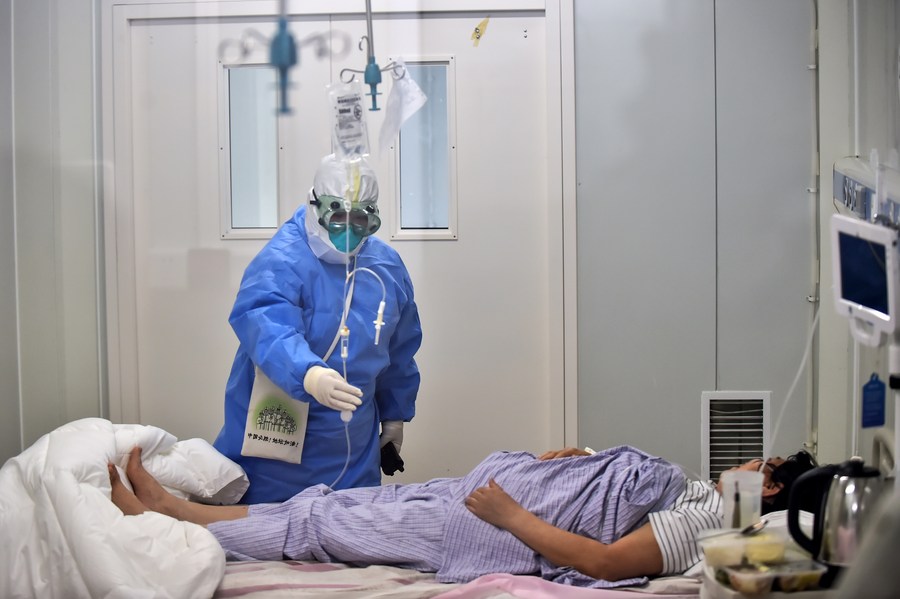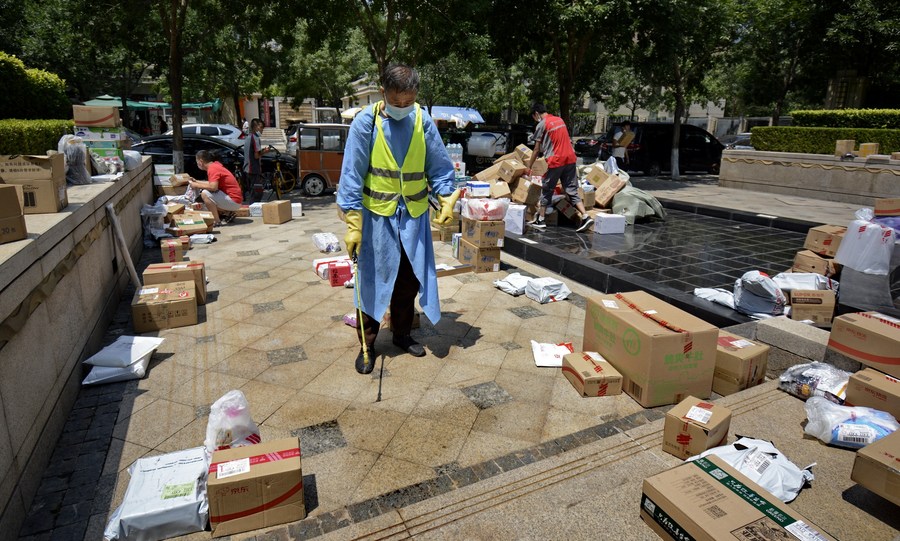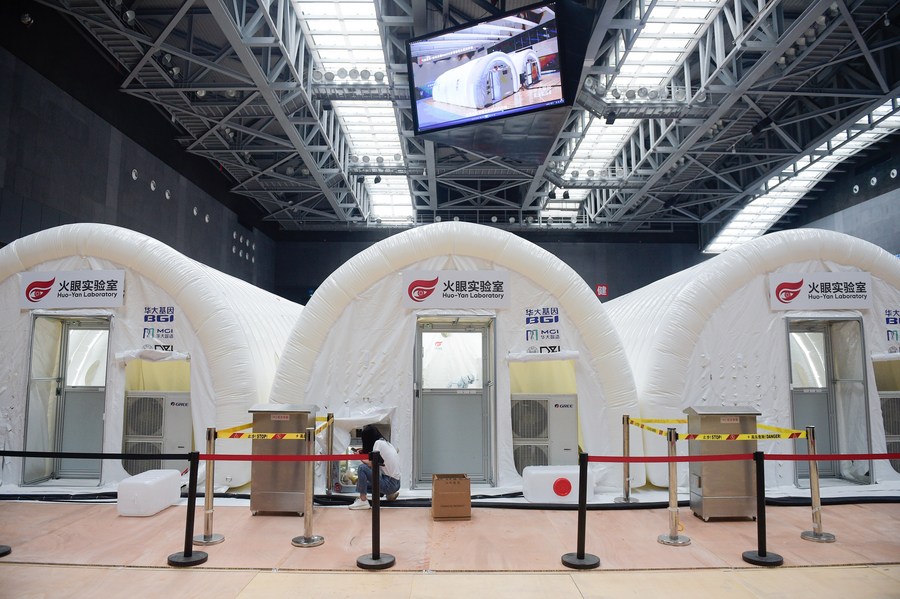Beijing tames new infections of COVID-19 in less than one month
Beijing has effectively controlled its recent outbreak of COVID-19 infections related to a major wholesale market as the city reported no new confirmed cases for the eighth consecutive day on Monday.
Beijing has effectively controlled its recent outbreak of COVID-19 infections related to a major wholesale market as the city reported no new confirmed cases for the eighth consecutive day on Monday.
From June 11 to Monday, the Chinese capital city reported 335 confirmed domestically transmitted cases, of whom 205 remain hospitalized and 130 were discharged from Beijing Ditan Hospital after recovery.
After the city saw a resurgence in locally transmitted COVID-19 cases, mostly related to the large Xinfadi farm produce market in Fengtai District, the municipal government adopted swift and targeted measures to curb the spread of the virus.

A nurse treats a COVID-19 patient at an isolation ward in Beijing Ditan Hospital in Beijing, capital of China, June 16, 2020. [Photo/Xinhua]
Here is a look at how Beijing has brought the new infections under control in less than one month.
Timely epidemiological investigation
Beijing reported a new confirmed locally transmitted COVID-19 case on June 11 after the city had seen 57 days with no such cases.
An epidemiological investigation was carried out immediately, which traced 38 close contacts. All places that the patient had visited and may have been potentially exposed to the virus, including Xinfadi, were identified.
On June 12, environmental samples tested positive for the novel coronavirus in Xinfadi. At the same time, more epidemiological investigations were carried out as several new confirmed cases were reported.
To control the new infections, the disease control and prevention centers at the city and district levels organized more than 500 epidemiological investigators, who can be immediately dispatched to conduct investigations if any new cases are reported.
"We usually have three people in a group, two go into the quarantine area, and the third is responsible for support and disinfection," 33-year-old epidemiological investigator Li Ruoxi said. He explained they communicated with the patient and his or her family about the patient's recent activities and contact history over the 14 days before hospitalization.

A man who was at high risk of exposure to the Xinfadi market receives hand sanitizer from a staff member after finishing quarantine at a designated facility in Beijing, capital of China, July 7, 2020. [Photo/Xinhua]
Thanks to timely and effective epidemiological investigations, Xinfadi was targeted as a high-risk location within 22 hours of the new outbreak. Beijing immediately suspended the market, closed down nearby residential communities and conducted concentrated medical observation of traders from Xinfadi.
Targeted lockdowns
To cope with the rebound in locally transmitted COVID-19 cases, Beijing deployed targeted lockdowns instead of confining everyone to their homes that risked reversing the gains made after the resumption of work.
Precise control measures have been taken by designating subdistricts and townships as low-, medium- or high-risk areas according to their epidemic situation.
In this way, the lives of people in low-risk areas would be minimally affected. With health QR codes showing their digital travel records, deliverymen and other service providers are allowed to enter residential communities, and residents can access certain public venues and travel in the city freely. Conversely, some key areas, apartment blocks and housing compounds in medium- and high-risk areas were put under closed-off management.
To prevent the spread of the virus, the city tightened the control of the flow of personnel to other places.
For example, those from medium- and high-risk areas and relevant people from the Xinfadi market were not allowed to leave Beijing. Previously, a negative nucleic acid test certificate issued within the past seven days was also a must for those who intended to leave the city. The certificates were no longer required for people from Beijing's low-risk areas starting from July 4 as the epidemic situation improved.

A community worker disinfects an area designated for delivery packages at a residential community in Jiugong Town, Daxing District, Beijing, capital of China, June 21, 2020. [Photo/Xinhua]
Huaxiang Township in Fengtai District, the only remaining high-risk area in the city, has been downgraded to a medium-risk area after fewer than 10 local confirmed cases had been reported for 14 consecutive days, said Liu Xiaofeng, deputy director of the Beijing Center for Disease Control and Prevention, at a press conference on Monday.
After the adjustment, Beijing was cleared of high-risk areas for the disease, and it now has a total of seven medium-risk areas, according to Liu.
Mass testing
To contain the spread of the disease, Beijing launched a citywide campaign to trace people who had visited the Xinfadi market since May 30 via door-to-door inquiries, calls, social media platforms and other methods. People working in the related farm produce markets, residents of nearby communities and people who visited the facilities have been identified to undergo nucleic acid tests.
The city has also prioritized testing for people living in medium- and high-risk areas, medical staff and frontline personnel, and employees of banks, grocery stores, restaurants, courier enterprises, food delivery platforms and hair and beauty salons.
More than 11 million people in Beijing, about half of the capital's population, underwent nucleic acid tests between June 11 and July 6, according to local authorities.

Photo taken on June 22, 2020 shows a COVID-19 nucleic acid test laboratory "Huoyan" or Fire Eye with air-inflated structures in Daxing District, Beijing, capital of China. [Photo/Xinhua]
To cope with the surging demand for tests, Beijing expanded the number of nucleic acid testing facilities from 98 in early June to 184 as of July 7.
Three COVID-19 nucleic acid test laboratories named "Huoyan," or Fire Eye, have conducted more than 1.2 million tests in Beijing in about three weeks. Two of them are mobile and inflatable labs.
As of July 11, the two inflatable labs have been dismantled. "After the removal of the labs, professionals will carefully disinfect the environment and the site can be used for other purposes," said Xiang Fei from BGI Genomics, one of the developers of the labs.
Beijing has contained the virus within one month by adopting comprehensive measures, including raising the response level, conducting collective medical observation of close contacts, and carrying out mass screening, said Wang Hufeng, a medical researcher at Renmin University.
Although the epidemic prevention and control in Beijing has achieved remarkable progress, the novel coronavirus can cause complicated and varied symptoms and it is highly contagious, said Pang Xinghuo, deputy director of the Beijing Center for Disease Control and Prevention.
"Citizens should not relax their vigilance. They should continue to protect themselves from contracting the virus and clean and disinfect their living and work environment on a regular basis," she said.

